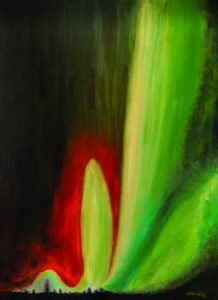Paintings of the Cosmos by Jerry Segal
I Am But Dust and Ashes,
For My Sake the World Was Created
May 14–July 29, 2018
Artist Reception • Wednesday, May 30 • 6-8 PM • Free and open to all
In awe of the vastness of the universe, Jerry Segal paints compositions of spiraling, billowing gaseous star formations known as nebula. His compositions are derived from NASA’s Hubble Space Telescope and evoke prismatic landscapes, trippy other-worlds or wildly chromatic abstract compositions.
 Introduced by NASA in April 1990, the Hubble Space Telescope is a scientific instrument that documents critical data enabling astronomers to measure the age of the universe, identify quasars, discover gamma-ray bursts, locate dark matter and see galaxies in different stages of formation.
Introduced by NASA in April 1990, the Hubble Space Telescope is a scientific instrument that documents critical data enabling astronomers to measure the age of the universe, identify quasars, discover gamma-ray bursts, locate dark matter and see galaxies in different stages of formation.
While the interstellar cosmos that Segal depicts represent a part of this universe that is real, it is wholly out of reach to the naked eye and will only ever be visually accessible to us through Hubble’s photographs. Powerfully, the instrument records star formations that are billions of light years away and therefore no longer even exist.
The unfathomable unknowability of the universe that intrigues Segal has likewise puzzled philosophers, scientists, artists and laymen for as long as humans have existed. Astronomers studying Hubble photos recently confirmed that there are
more than 200 galaxies and that some are as old as 13.2 billion years. Twenty-first century technology might provide us with valuable information merely hinted at centuries ago, yet Hubble’s images create more questions than provide answers.
For Segal, an essential question considers our human role in the scheme of the universe. While he aims for viewers to lose themselves in his compositions of hazy cosmic vapors, he also hopes to spur self-reflection about our human responsibilities to our physical environment and earth’s sustainability. Our planet’s resources are being depleted, and Segal’s images implore us to contemplate how we walk through the Earth and what values we prioritize.
Although the Holocene Epoch is the name of the current period of geologic time, many scientists propose that we call the epoch Anthropocene because human activity is modifying the planet on a geologic scale through radioactivity, deforestation, oil drilling, agriculture, fossil fuel consumption and the movement of people. From a
geologic perspective this means our behaviors and patterns over the past 50 years have accelerated change to the Earth’s systems that will mark the geologic record for millennia.
It is difficult to square the knowledge of our swift and substantial impact on the physical planet with Stephen Hawking’s assertion that the human species is mere chemical matter and is utterly insignificant. Segal wonders how, then, do we operate in this dual paradigm where humans are simultaneously inessential but also influential, and how do we grasp our moral obligations to each other and to the physical world that we inhabit for such an inconsequential period of time yet have such a great impact on?
Lending some clarity, a 17th century Jewish teaching with inherent tension states, “I am but dust and ashes, for my sake the world was created.” An expression of humility that acknowledges our impermanence, the first part expresses the idea, akin to Hawking’s, that humans are formed from dust of the earth and return as dust to the earth when our lives end. The second phrase affirms our individual uniqueness and validates that each of us holds meaning and greatness in the world.
Ensuring that we’re always reminded that the contradictory phrases reflect human conditions that actually work in concert, the teaching instructs us to write each phrase on separate pieces of paper and to keep them into our pockets. When we’re experiencing despair or over-confidence, we’re to pull out from our pocket the expression that will help ground us and keep our attitude in check. In brass-tacks terms, the expression confirms that our time is limited. We can walk through life with arrogance and do much to wreak destruction or with awareness that we shoulder great responsibility.
Certainly, as humans we do both. The imperative, which Segal’s inquiries conjure, is that we recognize the interconnections of our actions and that we take personal responsibility to cultivate solutions around protecting the resources that make up the foundation of our ability to thrive.
—Melissa Hiller, American Jewish Museum Director